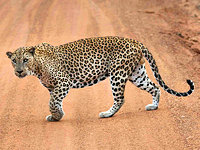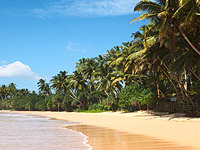Rediscover Sri Lanka

Fisherman's boat, Medilla Beach, Sri Lanka © Creative Commons/ Bleuchoi
With peace newly restored to beautiful Sri Lanka, this tear-shaped land of exotic beaches, vibrant culture and prowling wildlife is ready to be discovered once more. Daniel Neilson explores.
After clearing immigration at Sri Lanka's Bandaranaike International Airport, a sign met us: "Just arrived in the land of ------ miracles", the penultimate word covered in a patch of paper sellotaped to the poster. We later hear that the president, Mahinda Rajapaksa, himself demanded the word ‘small' be covered up on all tourism literature. "It's more than a small miracle," he allegedly argued. He was right.
The marvellous story of this tear-shaped - some say pear-shaped - island, linked by a thread of limestone shoals to India, is replete with myths of kings and concubines, and legends of medieval merchants who found such a vast wealth of spices and gems that the Sanskrit word for Sri Lanka, Swarnadip, became the word ‘serendipity'.
Following a bloody end to the 26-year Sri Lankan civil war between the Tamil Tigers and the government, and the recent tense election - and not forgetting the brutal devastation caused by the 2004 Asian tsunami - the country is finally enjoying peace and stability. Sri Lanka is on the tourist map once more, and visitors will find much to enthral.
Sigiriya
 Sigiriya, Sri Lanka © Daniel Neilson
Sigiriya, Sri Lanka © Daniel NeilsonWTG / Daniel Neilson
Near the geographical heart of Sri Lanka is Sigiriya, or Lion Rock. The most remarkable of Sri Lanka's seven UNESCO World Heritage sites, Sigiriya is a colossal rock, jutting out of the jungle. Through head-high lion claws carved at the base, a rickety iron staircase climbs around the overhangs and rocky undulations to a flat (ish) summit. Walls are decorated with remarkable fifth-century frescoes of scantily-clad, voluptuous ‘heavenly maidens'. On top are the remains of a palace, carved out during the reign of King Kashyapa I (AD 477-495). Sigiriya forms the centrepiece of what is known as the ‘cultural triangle', along with the Jethwana and Abhayagiri monastery at Anuradhapura, the Alahana Pirivena monastic university and the royal city of Polonnaruwa, and the caves of Dambulla.
Nuwara Eliya
Sri Lanka is the fourth largest tea producer in the world, and the central highland town of Nuwara Eliya - a bizarre mix of Sri Lankan highland life and Scottish colonial heritage, with a pleasant climate and breathtaking valley views - is considered the hub of the country's tea industry. A visit to a tea plantation, such as Glenloch, is a fascinating insight into your Ceylon tea bag. Nuwara Eliya also makes a great base when visiting Horton Plains National Park: a grassy sanctuary home to leopard, sambar, and the purple-faced langur.
Yala National Park
 Sri Lankan leopard
Sri Lankan leopardWTG / Daniel Neilson
Yala National Park, in the southeast of Sri Lanka, has what is thought to be the highest density of the endangered Sri Lankan leopard in the world. Although infiltrated by the Tamil Tigers as recently as 2008, and also acutely affected by the Asian tsunami, Yala is once again becoming Sri Lanka's key safari destination. Here, leopards are (fairly) easily found, along with crocodiles and buffalo. (Or, even better, crocodiles eating buffalo.) Another alluring national park is Minneriya National Park - home to an abundance of elephants and birdlife.
Galle
In the southeast corner is Sri Lanka's loveliest town: Galle. Pass a day wandering the ramparts and sea wall of the old colonial fortified city. The ubiquitous tuk tuks zoom around ox-pulled carts, and children play cricket on the greens, while the braver teenagers leap from the sea wall into deep and impossibly narrow pools among the rocks. Take tea in the colonial Amangalla Hotel, or grab a kadala - a fiery mix of chickpeas, chillies, curry leaves, onions and coconut eaten from a newspaper cone. Galle is most famous for its literary festival held each January; the 2010 festival saw author Ian Rankin and historian Antony Beevor descend on the town. Galle is also home to one of Sri Lanka's best hotels, Galle Fort Hotel.
Beaches
 Beautiful Sri Lankan beaches
Beautiful Sri Lankan beachesiStockphoto / Thinkstock
Whether it's marvelling at the stilt fishermen around Galle, or watching them haul the nets in, sat down reading an Michael Ondaatje novel, or riding a an elephant along pristine sand, much of Sri Lankan life, and tourism, happens on the beaches. The west and southern beaches are warmest between October and March, and the east coast beaches best March to October. There are dozens of good hotels just north of the capital Colombo in the town of Negombo; the Jetwing Beach is an excellent option. The seas can be rough around the southern coast - but the beaches remain spectacular.
Trincomalee
Described by British Admiral Horatio Nelson as "the finest harbour in the world", Trincomalee (or Trinco to the locals) has always been fought over, and its residents experienced some of the worst fighting during the recent war. Today, the Government soldiers, fingers on the triggers of AK-47s, watch over the town. However, this is a both fascinating and safe location, and one which deserves an afternoon spent walking the streets and markets, and chatting to the very friendly locals - cricket being the popular topic of choice.
Do you have any Feedback about this page?
© 2025 Columbus Travel Media Ltd. All rights reserved. No part of this site may be reproduced without our written permission, click here for information on Columbus Content Solutions.









 You know where
You know where